Last Updated on 25.04.2025 by hrushetskyy
We get it: You’re busy. And taking your car in for maintenance or repairs isn’t fun. For some people, it’s right up there with going to the dentist. You’re definitely not alone if you’ve neglected things like changing your oil or replacing your tires — as we discovered in our survey of 1,200 American car owners.
But letting car maintenance slide is a risky proposition. Days can turn into weeks or even months, potentially jeopardizing your safety, shortening the life span of your car, and leading to much more serious and costly repairs.
We surveyed drivers nationwide to uncover which car maintenance tasks they’re most likely to postpone, how long the delays last, and the reasons behind them. We also crunched the numbers to reveal the potential costs of neglecting routine upkeep. Read on to discover what we found:
- The 10 Most Delayed Car Maintenance Tasks
- 6 Reasons People Avoid the Mechanic
- The High Cost of Delayed Car Maintenance
- #1 The most-ignored car problem? Cracked windshields
- #2 Out of line: Driving with wheels needing alignment
- #3 Dirty Driving: Not getting regular oil changes
- #4 Tire tread: Letting car tires get bald or worn out
- #5 It’s probably nothing: Ignoring the “check engine light”
- #6 Can’t stop, won’t stop: Responding slowly to sluggish brakes
- #7 Squeaks, rattles, and groans: Ignoring unusual car noises
- #8 Going, going, going flat: Driving with a slow leak in a tire
- #9 Murky motoring: Running out of windshield washer fluid
- #10 Paddidle! Driving with a burned-out headlight
- Conclusion
- Methodology
The 10 Most Delayed Car Maintenance Tasks
Overall, Americans give themselves pretty high marks for how well they keep up with vehicle maintenance. In our survey of 1,200 car owners, 74.7% rated themselves “good” or “excellent” when asked how diligent they are about vehicle maintenance. Fewer than 4% rated themselves “pretty bad” or “terrible” at taking care of their vehicles. This was the breakdown:
But when we probed deeper, a whopping 91.8% of car owners admitted they’ve put off a car care task longer than they should. In many cases, the delays were less than a week long, but a surprising number of drivers have gone 30 days or more with wheels out of alignment, slow leaks in their tires, whining brakes, and more.

The most commonly ignored problem was a cracked windshield, with 42.4% of car owners admitting that they’ve waited 30 days or longer — watching as spidery cracks slowly spread — before repairing or replacing the glass.
About 1 in 3 drivers admitted postponing wheel alignments (35.3%) or oil changes (31%) for more than 30 days. More than a quarter of car owners admitted driving with bald or worn-out tires (27.3%), disregarding the check engine light (26.4%), or ignoring sluggish brakes (25.9%) for a month or longer.
Other items in the top 10 included overlooking a noise from the engine or wheels (24.4%), a slow leak in a tire (22.7%), an empty windshield fluid reservoir (21.9%), or a broken headlight (16.2%) for a month or more.
We’ll get into each of those in more depth in a moment — including how much it can end up costing if you delay each task. But given how risky it can be to procrastinate on car matters, we wanted to understand why people put off important repairs.
6 Reasons People Avoid the Mechanic
People gave us a variety of reasons why they let things slide.

The biggest factors were being too busy (54.3%), being unable to afford it (52.2%), thinking the problem was not urgent (34%), the length of time the repair might take (29.3%), anxiety around car-related issues (17.8%), and distrust of mechanics (13.4%).
Interestingly, anxiety and distrust of mechanics were slightly more of an issue for men than women:
- 18.4% of men said they delay car maintenance because of anxiety around automotive matters, compared with 16.9% of women.
- 14.3% of men said they distrust mechanics, compared with 11.8% of women.
Also, younger people feel more anxiety and distrust around automotive tasks than older people.
- 23.8% of people in their 20s said they have delayed repairs because of anxiety, compared with 8.9% of people in their 60s.
- 15.4% of car owners in their 20s said they distrust mechanics, compared with 12.7% of people in their 60s.
A 37-year-old man from Florida said:
A 50-year-old woman from Oregon told us a second opinion recently saved her from a big bill.
Last week, I was shocked to get a $1900 estimate for what I’d thought was a leaky power steering hose. I had almost decided to go ahead with it, but last minute, took it for a second opinion. The guy fixed it for $190. Thank God for second opinions!
The High Cost of Delayed Car Maintenance
Whatever the reason, neglecting car maintenance can be costly. Based on our analysis of actual car owner behavior, we calculated that delaying maintenance or repairs costs the average American driver an extra $1,193 over their vehicle’s life span. This figure is based on the rates of respondents ignoring an issue for 90 days or more, and the midpoint of the cost difference between prompt and delayed action.
Obviously, not all car owners delay the same tasks for the same length of time. Those who deal with all car problems promptly would have no excess costs as a result of ignoring warning signs. Those who delay multiple problems might have extremely high delay-related bills. This figure represents the average of all drivers’ estimated delay-exacerbated costs.

Many people would struggle to pay that amount if it happened in a single event. Our survey found that once the cost of a repair crosses the $1,000 threshold, fewer than half of American car owners can pull together enough money to get their car fixed.

Let’s look more closely at the specific car maintenance tasks that U.S. car owners admit to neglecting.
#1 The most-ignored car problem? Cracked windshields
Our survey found that windshield cracks were by far the most neglected car maintenance issue, with 26.7% of drivers admitting having ignored one for more than three months.

Why ignoring a cracked windshield is bad
Cracked windshields may not seem like a big deal, but the chips and spidery fractures caused by road debris are more than a cosmetic problem. As they spread, they can limit visibility and weaken the structural integrity of your car, putting you at much greater risk of injury during a collision or rollover accident.
How much it can cost
Many insurance policies cover glass repairs or replacement with no deductible, but if yours doesn’t, here’s what you can expect: If you catch a crack or chip early, it might be suitable for repair. Chips smaller than a quarter and cracks shorter than a dollar bill can often be patched. Generally, the smaller the blemish is, the cheaper it is to repair. Without insurance, glass repair typically runs between $60 and $125.
Windshield replacement costs vary by location, make and model of the vehicle, and the type of glass used. In one study of average repair costs in 16 U.S. cities, a replacement windshield for a Honda Accord cost $250 to $300, while one for a BMW X6 ranged from $350 to $450.

If you don’t replace your windshield and get into an accident:
- In a front-end collision, cars are designed to absorb impact with crumple zones. As the force moves to the passenger compartment, the curve of the windshield is supposed to reinforce the frame, enable the airbags to function properly, and prevent the windshield from collapsing in on the passengers and the A-pillars from folding inward.
- In a rollover accident, the strength of the windshield helps to absorb some of the impact and prevent catastrophic roof collapse as well as the injuries that could ensue.
- If poor visibility via defective windshield was a factor in the accident, you could be found negligent and liable for damages.
#2 Out of line: Driving with wheels needing alignment
The second most-neglected car maintenance task was getting wheels aligned. One in eight American car owners (12.5%) has driven for more than three months with a misaligned axle.

It doesn’t take much to knock a car’s wheels out of alignment. After bumping over a pothole or curb, you may start to notice your car pulling to one side. It takes more effort to control your steering. There may be some vibration in the steering wheel. Soon your tires start showing uneven wear and might even squeal a bit when you turn.
Most car owners we surveyed dealt with poor alignment within 15 to 30 days, but the longer you ignore the problem, the worse it can get. One in five car owners (22.2%) let it slide for two months or longer.
Why driving with misaligned wheels is bad
Improper alignment will decrease fuel efficiency. Uneven wear damages tires and increases the likelihood of shearing, punctures, and blowouts — which cause an estimated 200 deaths each year in the U.S. The extra stress can ruin your car’s suspension. Difficulty steering can increase the risk of an accident.
How much it can cost
Regular wheel alignments are recommended every 6 to 12 months or 6,000 to 10,000 miles, as needed. The average cost is $65 to $100, depending on the vehicle model and year.
Driving with misaligned axles can lead to higher fuel costs (maybe $20-50 a month), having to replace tires prematurely ($360-$600), having to replace the shock absorber and strut assembly (about $750), as well as other suspension and steering component repairs. And you’ll still need to get the wheels aligned.

If the misalignment leads to a crash, it could result in property damage, bodily injury, and even death. In that case, medical and legal costs could be astronomical.
#3 Dirty driving: Not getting regular oil changes
Engine oil is arguably the second-most important fluid in your car after fuel. It helps keep your engine running smoothly and prevents overheating. Most vehicles need oil changes every 3,000 to 6,000 miles.
In most cases, an oil change takes less than an hour, but many people still postpone doing it.

Modern cars usually have a dashboard light that comes on when you’re due for new oil. You also might have a sticker on your windshield with the date and mileage of your last change. Despite those cues, many people delay doing this mundane task.
The biggest group of car owners (38.3%) reported waiting 7 to 30 days past the recommended time to change their oil. Almost a third (31%) delayed by more than a month.
Why postponing oil changes is bad
Over time, oil can become thick and sticky. The engine has to work harder, leading to reduced fuel efficiency, sluggish acceleration, and a rough idle. Tiny particles build up and can act as abrasives, wearing down engine parts like crankshaft bearings, camshafts, and gaskets.
You might notice oil leaks and engine smoke from overheating. In the worst case, you can have a total engine seizure or failure.
How much it can cost
Oil changes typically cost between $35 and $75 for conventional oil and $65 to $125 for synthetic oil. The type of oil you need will depend on your vehicle model.
If you go more than 8,000 miles without changing the oil, you could end up also having to replace worn parts — possibly the valve cover gaskets (about $225), intake manifold gaskets (about $300), head gaskets ($1,290-1,560), camshafts (about $1,300-1,500), and crankshafts (average $1,642), among others.

If you still don’t act, eventually thick, dirty oil can result in catastrophic engine failure. Replacing the entire engine can cost $4,000 to $7,000 or more, plus $1,100 to $1,800 for labor — more than you’d likely have spent on routine oil changes over the life span of your vehicle.
A 31-year-old woman from Colorado told us neglecting oil changes was one of her “most expensive mistakes ever.” She said
I ruined a Lexus by blowing the engine when I was younger because I went too long without changing the oil. Ended up having to get a new vehicle.
#4 Tired tread: Letting car tires get bald or worn out
If you don’t examine the tread on your tires very often, you’re not alone. After all, most of us have other things on our minds when we enter or exit our vehicles — like getting from Point A to Point B.
But tires don’t last forever, and at some point, most car owners realize their tread is worn and they need new tires.

There are two common reactions when car owners discover this problem. One group replaces the tires within 24 hours (18.2%). The other group waits about three weeks (16.7%), rolling the dice that they won’t have a blowout or lose control of their car. A small contingent (8.3%) keeps driving on bald tires for three months or longer.
Why driving with worn tires is bad
Worn tires are thinner and more vulnerable to puncture by sharp items like nails or rupture from excessive heat. Tire blowouts can be dangerous, especially at high speeds. Tire tread provides traction to grip the road, especially in snowy and rainy weather. Loss of tread can lead to loss of control, hydroplaning, and difficulty braking, all of which are significant risk factors for car accidents.
A 57-year-old man from New York vividly recounted this experience, from the year after his college graduation.
I had a tire blow out when I was driving on the highway. I heard WHOOMF! and the car started slewing around. It was like a missle had hit the car. I pulled onto the shoulder and had to replace the tire all by myself. I had never done it before. I didn’t pull off far enough and it felt like everything shook as big trucks sped past me. But I got it done, and I made it to my friend’s place — and promptly fell asleep. And he was mad!
How much it can cost
Tires typically need to be replaced every two years. Purchased new, standard all-season car tires for everyday driving average about $80-$150 each, depending on size and warranty. SUV tires or light truck tires are a bit more, averaging $100-$250 each.
Quality used tires generally run from $25-$160, usually 30-50% of the price of a new tire of the same model.
If you ignore worn tires and they fail while you’re driving, it can damage the wheels and rotors. The average cost for wheel replacement is between $698 and $710. Wheel hub assembly replacement runs between $475 and $504.

And of course, if the tire failure leads to an accident, possible costs include getting a new vehicle, raised insurance premiums, medical costs, and/or legal fee.
#5 It’s probably nothing: Ignoring the “check engine” light
For some car owners, dismissing the “check engine” light is akin to hitting the snooze button. It’s a feature of the dashboard that, once ignored, becomes easy to tune out.

A full 15% of U.S. drivers admit disregarding a dashboard warning for more than 3 months. There are a lot of reasons why that’s a bad idea.
Why ignoring the “check engine” light is bad
Your car’s check engine light is its only way to communicate that something isn’t working as it should. Unfortunately, it doesn’t usually give you a lot of information.
The problem might be as minor as a loose gas cap, but it could also be a critical system like the fuel injection, ignition, or emission controls. Many problems worsen over time..
How much it can cost
There are myriad things that can trigger a check engine signal. One common problem that accounts for up to 10% of all check engine messages is a faulty oxygen sensor. Replacing an oxygen sensor right away costs about $350.

Ignoring that repair can decrease your gas mileage by 40%, cause power loss, and ruin your catalytic converter, which costs about $1,700 to replace.
#6 Can’t stop, won’t stop: Responding slowly to sluggish brakes
Movies often use brake failure as a plot device, with the main character suddenly finding that the brake pedal doesn’t work. In real life, brakes are far more likely to deteriorate gradually and become less responsive over time as brake shoes and pads wear thin.
By the time a driver notices sluggish braking performance, chances are, the components have been eroding for a while.
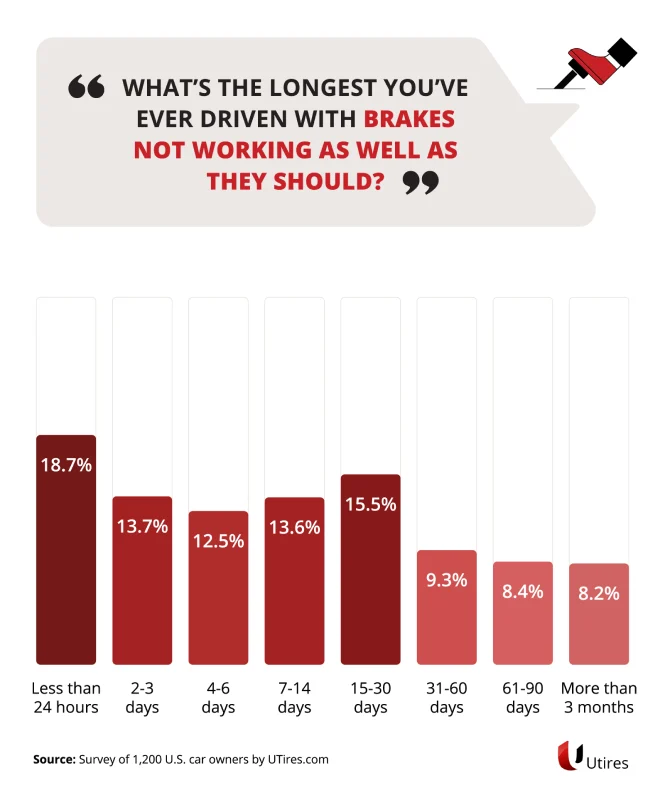
About a third of car owners (32.4%) spring into action when they notice a brake problem and get it fixed within three days. But a sizeable group (25.9%) lets the situation linger for a month or more.
Why driving with sluggish brakes is bad
Stopping is important. Bad brakes are a huge safety concern, slowing response time and risking collision with vehicles and pedestrians.
A 60-year-old man from North Carolina told us
I once, in my teens, let the brakes get so bad on a car — a horrendous grinding sound — that the tire itself caught on fire. Right in front of a Highway Patrol officer.
How much it can cost
Brake shoes and pads should generally be replaced every 25,000- 75,000 miles, depending on the vehicle and your driving habits. It typically costs about $100-150 per axle, depending on vehicle model and year.
Failing to replace brake pads promptly can lead to having to replace discs, rotors, calipers, and fluid. That will set you back between $300 and $800 per axle on average, but can easily climb above $1,000 depending on the make and model of your car
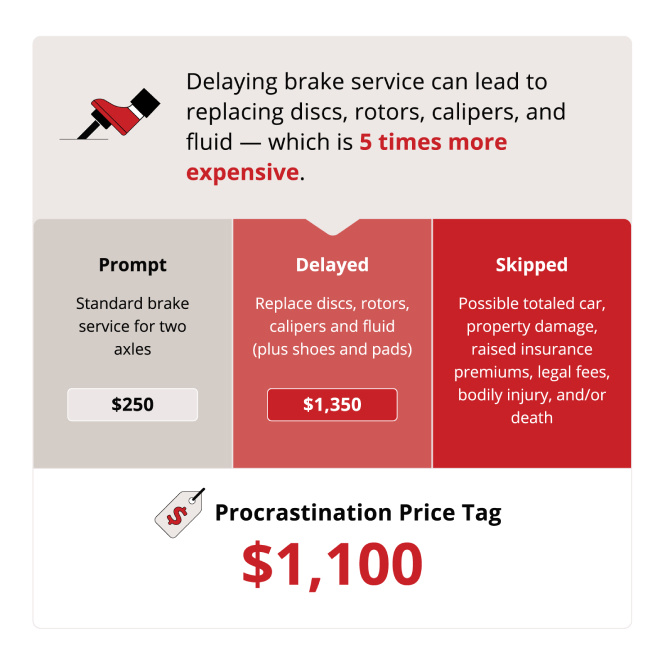
As we’ve mentioned before, if bad brakes lead to a tragedy, the human and financial cost could be incalculable.
#7 Squeaks, rattles, and groans: Ignoring unusual car noises
Cars are supposed to purr — not grind, wheeze, or squeal. But spend a few minutes at a busy intersection and you’re sure to hear the sounds of vehicles in distress.
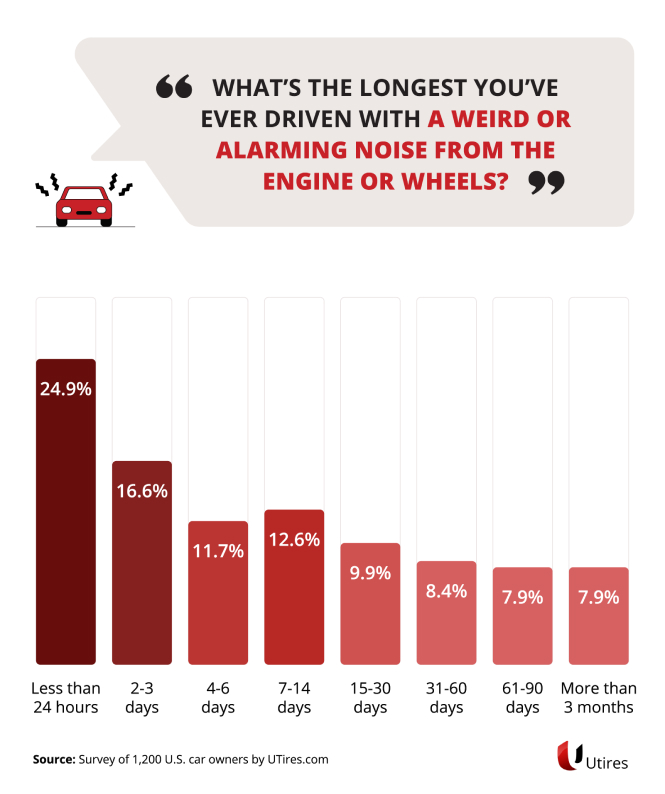
Most people take it seriously when their vehicle starts making weird or alarming noises, with 41.5% getting it into a mechanic within three days. But not everyone is as diligent. Nearly a quarter of car owners (24.4%) have ignored car noises for a month or longer.
Why ignoring car noises is bad
Different noises can signal different issues. Squealing noises are usually brake-related. (Brake pads have a built-in wear indicator that’s designed to make a high-pitched noise when it comes in contact with the brake rotor.)
Ticking sounds from the engine often mean the timing belt is starting to fail. Clunking or banging under the hood might be valves, connecting rods, or pistons.
Popping or clicking sounds when you turn could be the CV joints on your front axle. Howling or singing noises might indicate a fluid leak or bad wheel bearings.
Most problems that involve noises get worse over time. As expensive as a timely repair might be, it’s a safe bet that procrastinating will raise the price tag as well as the safety risk.
How much it can cost
Many things could be wrong when your car starts making weird noises, but one common scenario is a bad timing belt. The timing belt is a rubber and nylon component that connects the engine’s camshaft and crankshaft, keeps them in sync, and makes sure each cylinder fires at the appropriate time.
Timing belts are often replaced as part of scheduled maintenance every 80,000 to 100,000 miles. Having a timing belt replaced before it breaks typically costs between $576 and $659.
Waiting for your timing belt to snap before replacing it raises the cost by a lot. When the belt breaks, the valves and pistons no longer run in sync and collide with each other. This can bend the valve stems, gouge the pistons, crack the connecting rods, and damage the engine’s cylinder walls.
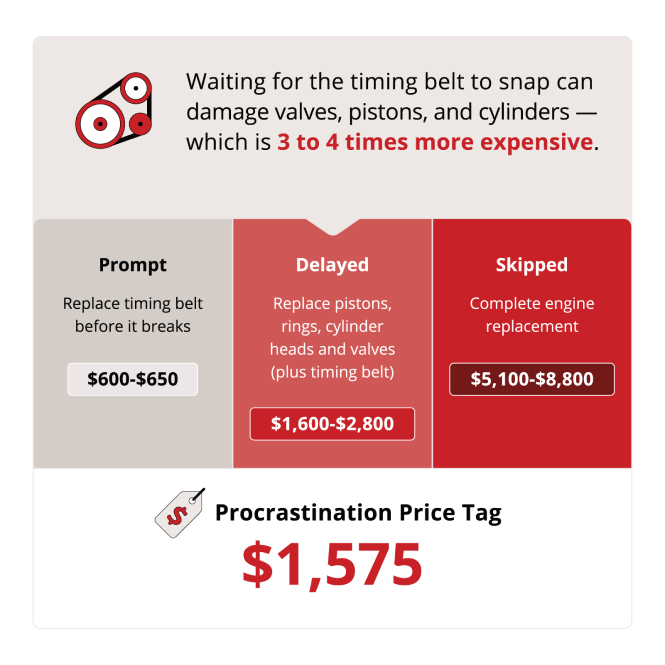
In a worst-case scenario, if the timing belt breaks at high speed it can crack the engine block, requiring a complete engine replacement.
#8 Going, going, going flat: Driving with a slow leak in a tire
There’s a reason most gas stations have air pumps that cost $1 to $1.50 per use. Some car owners would rather keep adding air to a tire with a slow leak than get it plugged or replaced right away.
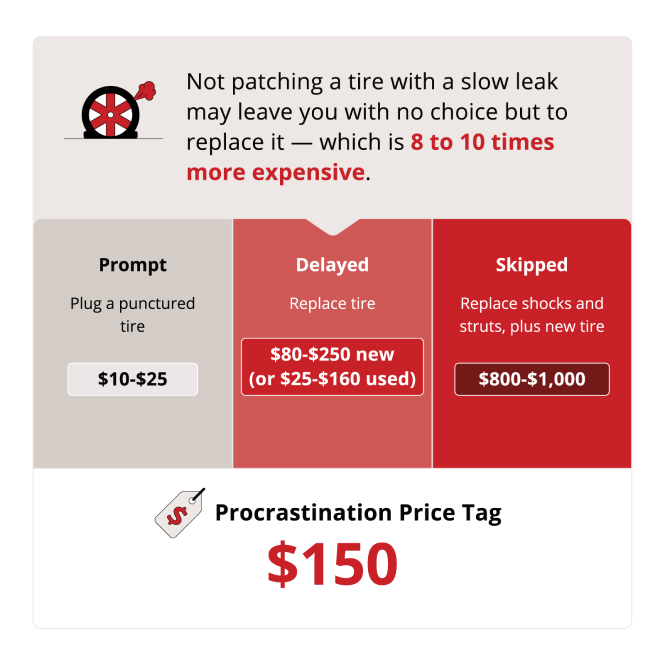
Although 40.3% of car owners fix leaky tires within three days, more than half use temporary fixes like adding more air to delay having to patch or replace them.
Why driving with a slow leak is bad
Air pressure is important for tires to function properly. Driving with underinflated tires decreases your fuel efficiency, as your car has to work harder to run. More rubber makes contact with the pavement, causing greater friction and wear and tear, which can lead to tire blowouts.
Underinflated tires make steering more difficult, hindering your ability to avoid an accident with quick evasive maneuvers. They also put stress on your car’s suspension, chassis, brakes, and rotors.
How much it can cost
Plugging a simple nail hole generally costs between $10 and $25. Some tire dealers will do it for free if you purchased your tire from them.
But continuing to drive on a tire with a slow leak damages the tire and puts greater pressure on the corners of the suspension and chassis.
The suspension’s struts and shocks control the entire weight of the vehicle, and a soft tire can cause them to wear out faster. Replacing shocks and struts costs an average of $766-$816.

A 26-year-old California man who neglected a slow leak shared:
The tire blew out next to a cemetery and I had to learn how to change a tire for the first time in a cemetery parking lot. But I got to say hi to my late grandmother in the process
#9 Murky motoring: Running out of windshield washer fluid
Windshield wipers are the solution to smeared and grimy windshield glass, but only if there’s fluid in the reservoir tank.
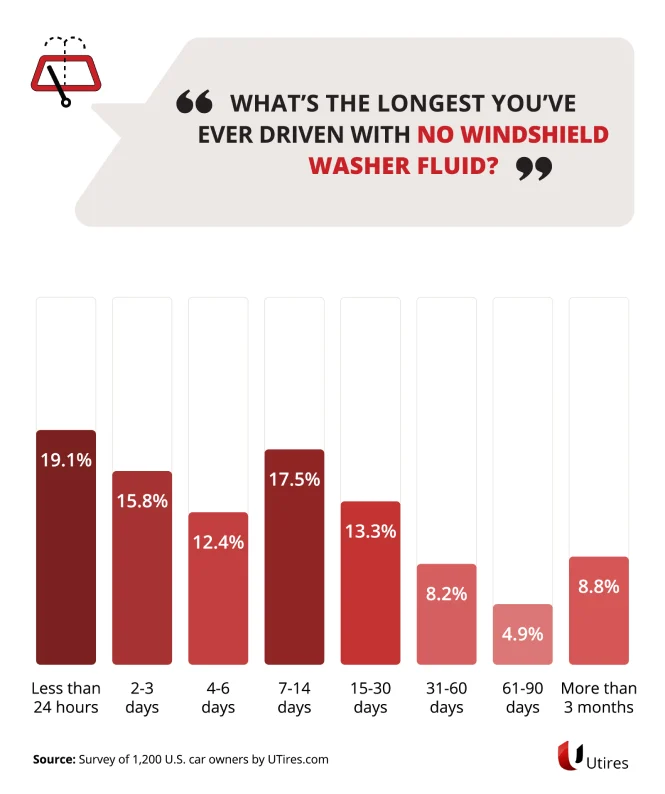
Why driving without windshield washer fluid is bad
Mud, pollen, bugs, rain, and snow can all obscure a driver’s view — and the worse your visibility is, the greater your risk of getting into an accident. Low visibility conditions are blamed for 38,700 vehicle crashes, 16,300 injuries, and 600 deaths each year, according to the U.S. Department of Transportation.
How much it can cost
Topping up the windshield fluid is a courtesy service at most garages. But if you want to do it yourself, you can pick up a gallon of basic windshield washer fluid at almost any big-box store, gas station, or grocery store for about $2-3. (Deluxe formulas with additives to repel rain or remove bug residue may run closer to $15.) Then just open the hood and look for a reservoir on the right or the left. It should be easy to spot; it will have a plastic cap with a windshield symbol on it.
A few dollars for windshield fluid is a small price to pay, especially considering the risk of an accident if you can’t clear an obstruction from your view.
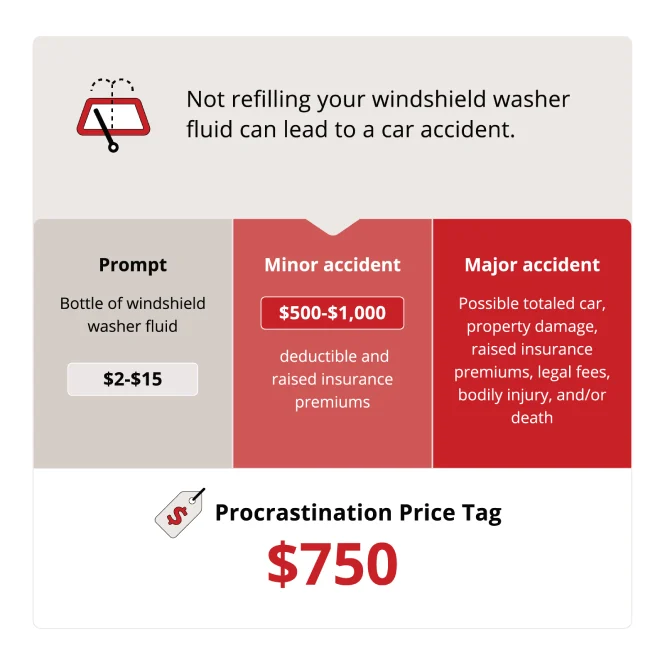
#10 Padiddle! Driving with a burned-out headlight
You may feel like you can see and drive just fine with one headlight out, but doing so is inadvisable from a safety perspective — and it’s illegal in most states.
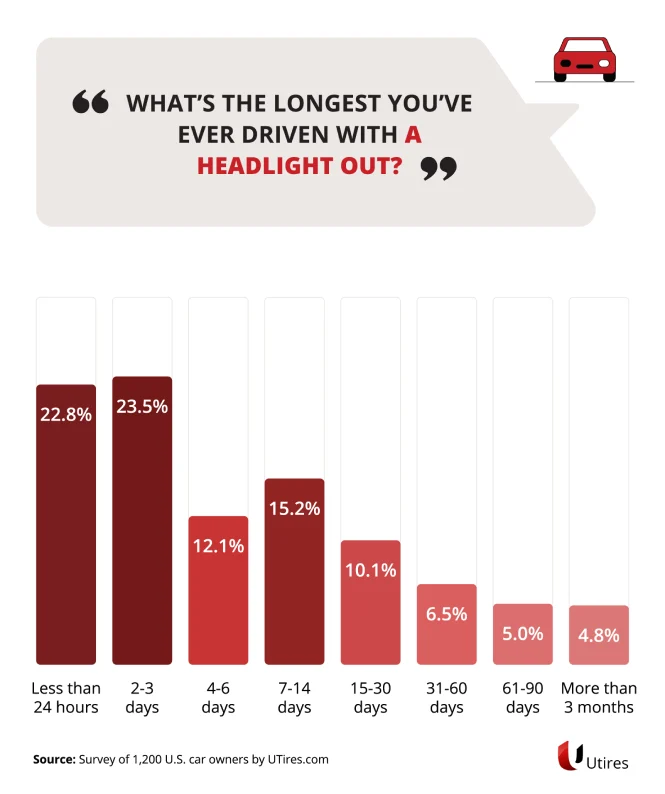
Why driving with a headlight out is bad
Most states have laws requiring headlight use from sunset to sunrise for the simple reason that it’s safer. It’s easier for drivers to see and be seen by others with both lights on. Having a burned-out headlight makes it riskier to drive on roads that aren’t well lit. It also increases the chances of a collision.
How much it can cost
A basic halogen headlight bulb costs about $10-$20. In many cases, car owners can replace it themselves. However, if the bulb assembly is hard to access and you need help, labor costs average about $50 per bulb.
If you get pulled over for a burned-out headlamp, it’s possible that the officer will let you go with a warning. But there’s also a significant chance that you’ll get a citation and points on your license. Tickets typically run from $80 to $120, depending on the state.
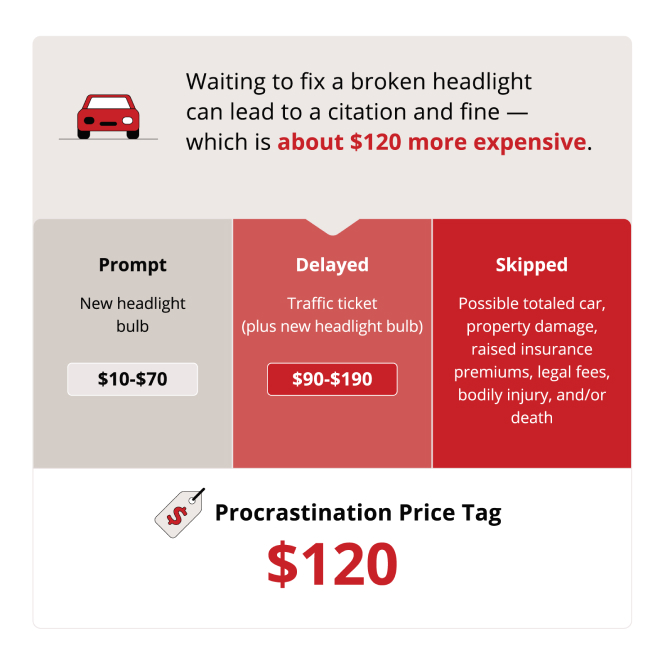
Conclusion
When time and money are both tight, it can be tempting to let car maintenance slide — especially if your vehicle is still operable and driving reasonably well. But delaying seemingly small car care tasks can turn little problems into big, expensive ones. In the worst-case scenario, ignoring car repairs can have deadly consequences.
There are many affordable ways to prevent the sticker shock of a major repair. Windshields and tires can often be patched, if you catch the problem early enough. You can refill windshield washer fluid yourself for a few dollars, rather than risk being blinded by a mud splatter. Checking reviews is a good way to find a reputable mechanic who won’t overcharge or upsell you. And buying quality used tires can be a safe, affordable alternative to paying full price for new ones.
Methodology
Our study was conducted online. We surveyed 1,207 U.S. residents who have owned a vehicle for at least two years and are primarily responsible for the vehicle’s maintenance. Respondents were 57.7% male and 41.7% female. Seven people (.6%) identified as non-binary.
Participants ranged in age from 18 to 76, with a median age of 37. They came from 48 states (all but Alaska and Vermont) with a distribution as follows: South, 447 (37.5%); West, 279 (23.4%); Midwest, 240 (20%); Northeast, 229 (19.1%) – based on U.S. Census-defined regions.
The median household income was $50,000 to $75,000 with 39.5% earning less and 35.4% earning more.
The survey was based on self-reporting, which can have limitations. However, the margin of error was ±2.82% with a confidence interval of 95% based on the estimated population of 237.3 million car owners in the U.S.
Price estimates came from several aggregator websites including RepairPal, AAA, Kelley Blue Book, Edmunds, and AutoServicesCosts.com. The estimates use the MSRP (manufacturer’s suggested retail price) for parts and automotive industry standard labor times and rates. Costs were generally presented as ranges, since many variables can influence actual price, including the make, model, year, condition, and location of the vehicle.
For the “procrastination price tag” figure, we used the midpoint of the cost difference between prompt and delayed action. For the average total cost of delayed maintenance, we accounted for the probability of each consequence actually happening by multiplying the “procrastination price tag” by the percent of respondents who ignored each issue for more than 90 days.
Fair Use
If you are a journalist or blogger interested in covering this project, there’s no need to delay using our research. You’re welcome to reproduce any of the findings or images in this article for noncommercial use. All we ask is that you give proper credit by linking back to this page.

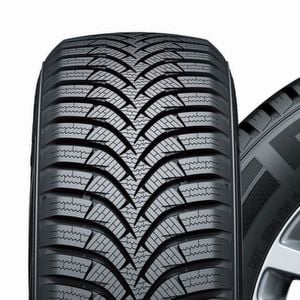
My first car was a Mustang and every time I brought the thing in, they told me it would cost $700 to repair. It was odd. Every time, without fail, they found something wrong enough with the car to come up with a $700 bill. I haven’t really trusted mechanics since then.